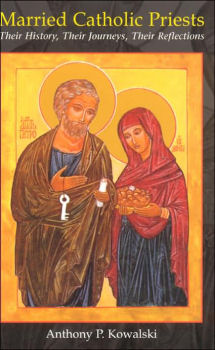
|
Posted January 30, 2006
Book: Married Catholic Priests: Their History, Their Journeys, Their Reflections Author: Anthony P. Kowalski Crossroad Publishing Company, New York, 2005, pp.264 An Excerpt from the Preface:
Pope John XXIII grieved over this. As papal nuncio in Sofia, Bulgaria, he had befriended Orthodox married priests and respected them. As papal nuncio in Paris, France, he dealt with worker-priests and admired their efforts. These experiences led to greater compassion toward priests. His friend, the German theologian Bernard Haring, wrote that John XXIII on his deathbed expressed regret for not resolving the matter of priests who marry. Pope Paul VI, aware of his predecessor’s concerns, resolved to do something about them. Although opposed to discussing celibacy at the Second Vatican Council, he put in place in 1964 a judicial procedure for dispensing priests and allowing them to marry. Roman officials handled these matters privately until 1972, when the norms were made public. A major exodus followed. Requests for dispensation flooded to Rome from parish curates and high dignitaries, form remote mission territories and major urban areas, and from every diocese and religious congregation in the world. At the press conference in June 1991 the undersecretary of the Congregation of the Clergy in Rome estimated that the Vatican had granted sixty thousand dispensations. Pope John Paul II, upon taking office in 1978, halted the process. But he then authorized the ordination of married Episcopal, Lutheran, and other Christian ministers who converted to Catholicism. This happened when ordained Catholic priests were marrying and being accepted as pastors and bishops in Protestant churches. Never before has the Roman Catholic Church witnessed anything like this. First, former Protestant clergy are working as married priests in Roman Catholic parishes. Second, ordained Roman Catholic priests are accepted as married pastors in Protestant Churches. Third, ordained Roman Catholics priests are working as married laymen in Roman Catholic institutions. Fourth, Roman Catholic clerics, denied dispensation, marry and continue sacramental ministry without church sanction. Fifth, the ordination of women a generation ago by a Roman Catholic bishop in the underground church of Czechoslovakia and the ordination of seven Catholic women by Old Catholic bishops in Austria have been verified. A further dilemma arises from the dwindling number of celibate priests. Catholics and other Christians in need of pastoral care are requesting sacramental ministry from former clerics, who are eager to respond – preaching the Gospel, celebrating the Eucharist, and performing baptisms, weddings, and funerals. With Christ they say, “What man among you, if his son asks him for bread, will give him a stone? Or if he asks for fish, will give him a serpent. An Excerpt from the Book: The Third Millennium Many expected that, with the millennium celebration focusing on reconciliation, the Church would address the treatment of married priests. Cardinal Basil Hume suggested such reconciliation directly to Rome. In the name of the bishops of England and Wales, Hume formally requested amnesty for married priests and for their return. He passed away not long afterward without receiving a response. The opening years of the third millennium saw a plethora of sympathetic calls for reform. When revelations of clerical sexual abuse in the United States stunned the nation, The Pilot, official newspaper of Cardinal Law’s Boston Archdiocese, in March 25, 2002 called celibacy an issue that ‘simply will not disappear.” On March 25, 2002, Cardinal Roger M. Mahony of Los Angeles said, “The Eastern Catholic Churches have always had a married priesthood, and it works out fine. . .So I think it should be discussed. Table of Contents: Part 1 Historical Background 1. The other tradition 2. Beloved wives 3. Organizing priests Part 2 Post-Clerical Journeys 4. The Humanae Vitae debacle 5. Working for the Church 6. Diversity among married priests 7. Prominent former clerics 8. The swinging door 9. Spirituality and married priests Part 3 Personal Reflections 10. My journey 11. Priests in transition 12. A nurturing parish 13. The cultural revolution 14. Married priesthood today Conclusion |
|
